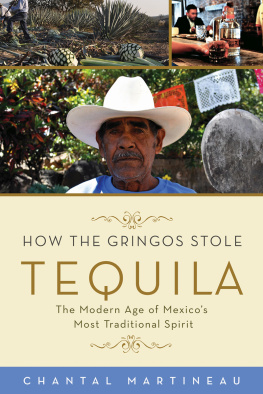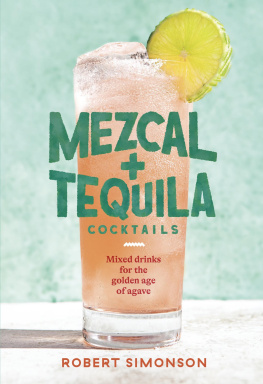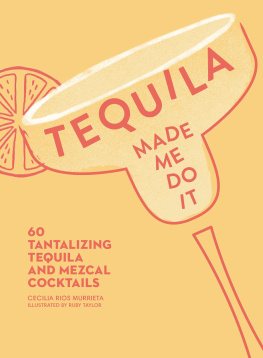T equila is one of the fastest-growing spirits categories in America, the margarita the countrys most popular cocktail. But no longer is it only cheap party fuelit has become Americas luxury sipping spirit. How the Gringos Stole Tequila eloquently traces this extraordinary evolution.
As Chantal Martineau makes clear, theres far more to the story than an upmarket trend shift. Martineau spent several years immersing herself in the world of tequilatraveling to visit distillers and farmers in Mexico, meeting and tasting with leading experts and mixologists around the United States, and interviewing academics on either side of the border who have studied the spirit and its raw material: agave.
How the Gringos Stole Tequila addresses issues surrounding the sustainability of the limited resource that is agave, the preservation of traditional production methods, and the legal constructs designed to protect tequila from counterfeiting. It examines the agave advocacy movementmade up of agave growers, distillers, bartenders, importers, and scholarsthat has grown up alongside the spirits swelling popularity.
But besides detailing the culture and politics of Mexicos most iconic liquid export, this book also takes readers on a colorful tour of the countrys Tequila Trail, as well as introducing them to the mother of tequila: mezcal. Including an unprecedented drinking guide to Mexicos agave-based spirits and a stunning collection of full-color photographs of the production process, How the Gringos Stole Tequila will long remain the definitive look at the evolution of North Americas only truly native spirit.

Copyright 2015 by Chantal Martineau
All rights reserved
First edition
Published by Chicago Review Press Incorporated
814 North Franklin Street
Chicago, Illinois 60610
ISBN 978-1-61374-905-0
Library of Congress Cataloging-in-Publication Data
Martineau, Chantal.
How the gringos stole tequila : the modern age of Mexicos most traditional spirit / Chantal Martineau.
pages cm
Includes bibliographical references and index.
ISBN 978-1-61374-905-0 (cloth)
1. TequilaHistory. 2. Tequila industryMexicoHistory. I. Title.
TP607.T46M36 2015
338.476635dc23
2014036114
Interior design: Jonathan Hahn
Interior photos: Chantal Martineau
Printed in the United States of America
5 4 3 2 1
For Richard and Rita, thanks to whom Im high on life.
CONTENTS

Index
{PREFACE}
In the Beginning, There Were Body Shots

One tequila, two tequila, three tequila, floor.
G EORGE C ARLIN

I n a dusty field, under a high, hot sun, a man is working the land. He looks like a cowboy, wearing crisp blue jeans with a big-buckled belt, a clean white shirt, and a wide-brimmed hat curled up at each side. His mustache is epic: thick, black, and curved down around the corners of his mouth, framing it like a photograph. He doesnt smileor, if he does, the brim of his hat shadows it from sight. Squaring his hips and winding up like a batter, he grips the long rod of his primitive-looking instrument as he plunges its blade down into tough, fibrous flesh.
Were in an agave field in the state of Jalisco in central-western Mexico, surrounded by large spiky plants that look like aloes on steroids, the sun beating down like an audible presence. The instrument in question is called a coa de jima, a long-handled hoe designed specifically to harvest agave, the native succulent plant from which tequila is made. The coa, forged by a local blacksmith who specializes in the rustic tool, looks tarnishedantique, evenbut its dangerously effective thanks to regular and careful whetting by its user. The rounded blade lops off several of the plants long, plump leaves as it sinks into its monstrous pale yellow heart: the pineapple-like core aptly called the pia. Each strike produces a satisfying thwack. Its tempting to steal a glance at the mans sandaled feet, browned from the sun and grimy from the sandy soil, to count the ten toes he still has (just to be sure) as he winds up for another strike.
Its hot. Inevitably, ones thoughts turn to icy margaritas. But out here, in the agave fields in the heart of tequila country, there is not a frosted cocktail pitcher in sight. The work the man is doing is much harder than he makes it look. He is the latest in a long family line to do this for a livingthat is, until his son or nephew gets inducted into the brotherhood of men who harvest agave for tequila production. Its a highly skilled task, a job shrouded in lore, that for hundreds of years has been passed down from generation to generation.
Here is where I wanted the story to begin: amid the blue-green expanse of an agave field, under the unrelenting Mexican sun, sweat beading on the brow of a rugged man immersed in the age-old task that first gave birth to what is now called tequila. But for most of us the story of tequila starts in a much different way. Like, back when we first had the misfortune of being introduced to the hot, harsh liquid a great number of people have come to associate with tequila. To tell the story of tequila properly, one has to recall days probably best left forgotten and, too often, virtually impossible to remember anyway. Ones initial encounter with the spirit is rarely a pretty one. In my case, the story starts when I was still a snot-nosed college kid experimenting with freedom and self-destruction, much like you might have done at that age. The tale of my first tequila is not one I like to tell, for fear of glorifying youthful stupidity and the crude way many people think tequila should be taken. Yet, its important to acknowledge how most of us came to know tequila in order to fully understand how itand we, as imbibershave evolved.
The story usually goes something like this: salt, shot, lime wedge worn like an unhappy smile, repeat. In the worst of cases, the ritual ends in a blackout. In fact, thats exactly how my story went. The memory is fuzzy, but it involves a dare and multiple shot glasses all lined up in a row, each one filled with a clear liquid you could smell the moment the bottle was uncapped. The shots were accompanied by the customary lick of table salt from the back of the hand to anesthetize the tongue and wedge of lime to take the edge off the sting afterward. The lime doubled as something to bite down on as I shivered and gagged, the painful burn drawing a line down my esophagus. The taste is permanently etched into my brain. Like gasoline cut with rubbing alcohol, then cut again with dirty socks. The ensuing drunkenness that first night came on as it does in a cartoon. I hiccuped. My eyes stopped blinking in unison. The rest is a blur.
Sound familiar?
Tequila is only now beginning to recover from its longtime reputation as the firewater of our youth. A certain breed of drinker has discovered tequilas potential as a complex and sophisticated sipping spirit, but the vast majority of people still associate it with salt, lime, bad decisions, and a nasty hangover. Yet what so many of us recall haplessly knocking back in those bad old days is not even true tequila. Or rather, it isnt pure tequila, distilled from 100 percent agave, those big desert plants often mistaken for either aloe or cacti. Instead, most of us were introduced to tequila via something like Jos Cuervo Especial, that sweet golden poison, which is actually a cheaper, less-refined hybrid distillate derived from just 51 percent agave. The popular term used to refer to tequila that is not made from 100 percent agave sugars is
Next page











